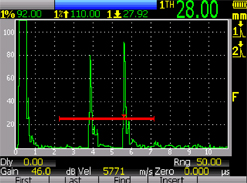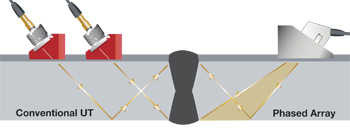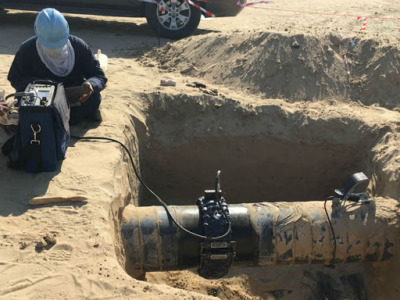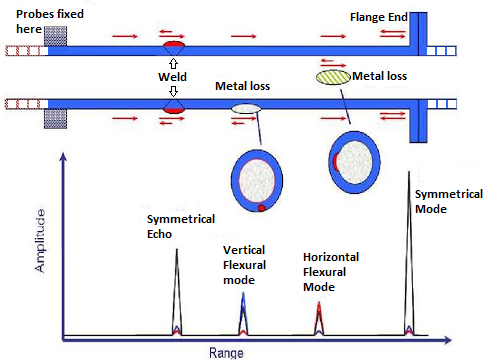AQC Inspection provides some information on advanced Ultrasonic Testing (UT ) methods here.
Conventional Ultrasonics:
Conventional Ultrasonic method is generally used in all industries, since it was invented in the year 1940 by Dr.Floyd Firestone an U.S researcher from University of Michigan and named it “Flaw Detector & Measurement Device”.
The method involves generation of sound waves at high frequency. The crystal which creates the sound vibrates minimum 20,000 times per second. The created sound is sent into the test material and the sound returns back to show the travelled distance (i.e the thickness of the material). If the sound meets any defect on it path then also the sound returns back and show the depth of the defect.
The Machine represents data’s in echo pattern as shown here:

Conventional Ultrasonic nowadays is a familiar method in every industry including Medical Science.
The disadvantages of conventional Ultrasonic are-
- The sound has to be sent at different angles using different probes to detect defects t different orientation
- The probe/ scanning unit has to be moved to and fro by human hand to scan the full depth.
- If there is no required area called Skip distance to move the scanning unit to and fro, then inspection cannot be done
- The resolution is not great with the conventional UT view called “A-scan view”.
Introduction to Advanced NDT Methods:
Latest Inventions have given us advancement in technology , few are given below:
- Phased Array Ultrasonic Testing ( PAUT )
- Time of Flight Diffraction Ultrasonic Testing ( TOFD )
- Long Range Ultrasonic Testing ( LRUT )
1)Introduction to Phased Array Ultrasonic Testing (PAUT)

Phased Array Ultrasonic scanning unit involves many crystals arranged in a manner that it sends sound waves in different directions inside the material. The sound from different crystals are timed by the computer at different phases – hence the name Phased Array (Timed elements & Arrangement of elements)
The major Advantage of the technology are:
- Inspection is quick , since the manual to and fro movement by the user is not required.
- More possibility of finding defects without using different angle probes, since a single probe scans in different direction.
- PAUT gives multiple view of the defects through advanced presentation views such as B scan (depth of defect) view, C Scan View(Top view), S Scan view (sectorial view) and conventional A scan view (echo pattern ).

Complete scanning can be recorded and interpretation can be made later by many number of people. So the technology is believed to be reliable process for inspection.
2) Introduction to Time Of Flight Diffraction UT (TOFD)
The technology is used for Crack detection at a rapid rate. The method involves two Ultrasonic probe a “transmitter’ and a “receiver” attached to a fixture.The fixture can be operated manually or robotic. The technology finds defect by analyzing the time of sound travel and sound diffracted from the crack tips, hence the name “ Time of Flight Diffraction”

The TOFD methods give visual representation of the defects as shown here.The technology exactly locates the defect and measures the size of the defect.
3) Introduction to Long Range ultrasonic Testing / Guided Wave Testing
The Technology is used to scan a complete length of pipe for internal corrosion, cracks or damages.
Long Range UT involves multiple Probes fixed around the circumference of the pipe. The sound is sent in a manner it travels through the wall of the pipe up to the end (Flange ) of the pipe and returns back. The low frequency sound waves are sent to avoid loss of sound due to scattering .
The sound reflected from the obstructions are shown in the screen. The A-symmetrical sound echoes are identified as defects and locations of the defect is shown in the sweep range of the screen.
The size of the defects are also can be interpreted by using Distance Amplitude Curve.


The major advantages of Guided Wave testing or Long Range UT are:
- It is a speedy testing method, a long length of pipe can be scanned quickly
- Full access of the pipe length is not required
- Even Insulated or underground pipe can be scanned without excavation the whole pipe length.
Still there are more advanced Ultrasonic Testing Technologies such as Laser Ultrasonic Testing, Immersion Ultrasonic Testing, we will keep you updated , stay in touch.
For training and certification in latest technologies, visit us at https://aqcinspection.com/ .
We are dedicated to train and provide QA and QC certification & qc courses such as NDT training and NDT certifications, welding inspection course, piping inspection courses, painting inspection courses through best training centers located in India.
Visit our Blog site https://advancedqualitycentre.blogspot.com to get updates.
